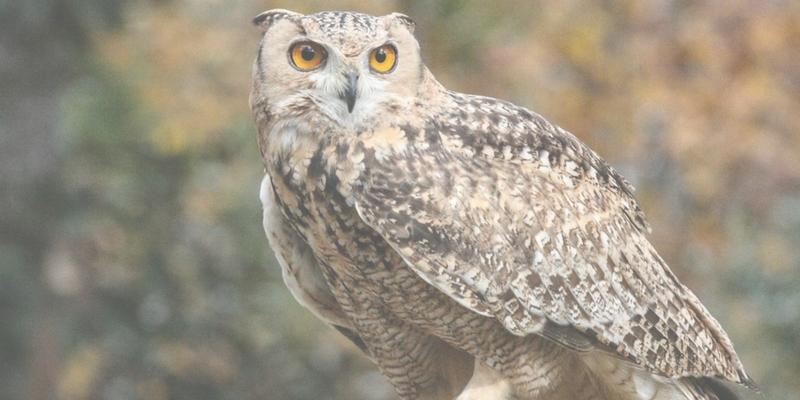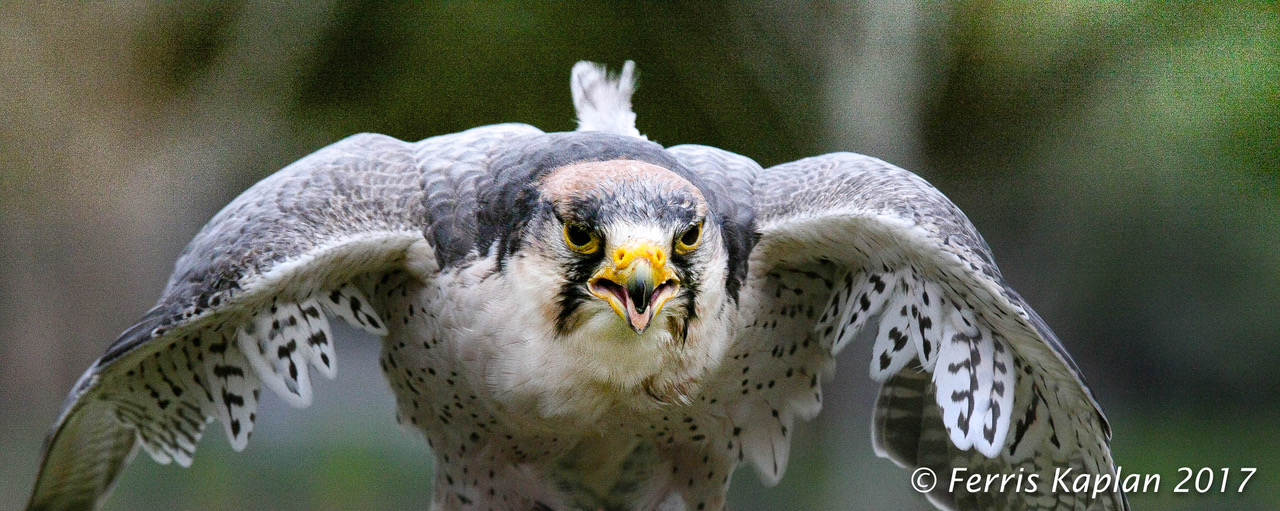
By Helen Mitternight
It’s a cloudy, chilly morning and they’re calling for the rat.
I’m surrounded by men and women peering through lenses short and long aimed at where, just a second ago, a huge Eurasian Eagle Owl has been perched, its wide golden eyes staring back at the impassive eyes of more than 20 camera lenses. The lenses win the staredown and, with a flapping of wings that sounds like sails in the wind, the owl soars off to sit high up and unreachable in a tree. Stephen Schabel, the director of education, waves the corpse of a day-old chick enticingly. The owl stares, then looks off in the distance, ignoring Stephen and lost in whatever thoughts an owl has.
This is Photography Day at the Center for Birds of Prey, a nonprofit started in 1991 that has seen more than eight thousand birds come through its doors, many too injured or imprinted on humans to ever fly wild. These majestic birds still manage to retain something of the wild, though, and one look at their razor talons or their needle-sharp beaks engenders the respect to stay well back.
The volunteers bring out falcons, hawks, an osprey and even an eagle all not-so-ready for their closeups. The staff has set up a perch for the birds to preen and show off. One by one, the birds brought out turn tail-feather to the avid photographers, making it hard to get the money shot they all want.
“The wind is coming toward you,” volunteer Lance says apologetically. “They don’t like to have the wind blowing up their tails. You’ve heard the expression ‘ruffle your feathers’? That’s what the wind does if it comes at them from the back.”
That’s not the only expression we humans have borrowed from our avian friends. The Lanner Falcon is brought out in a leather hood that fits over his whole head to keep him thinking it’s night-time.

“You’ve heard the expression, ‘hoodwinked’,” Lance says.
Photography Day is one of several special events the center holds throughout the year in order to educate the public to appreciate the birds, to fund breeding the birds for other wildlife programs, and to fund rehabbing the birds that have been hit by cars, flown into telephone lines, or otherwise been injured by humans’ presence. They also maintain a readiness team for disasters like oil spills.
The photographers move over to an outdoor arena where the owls are brought out, swooping low over our heads to land on their perch. The owls are enticed with food, as are all the birds, but they take much longer to lift off than the hawks or falcons.
“Owls are hard to train because they are very deliberate,” Stephen says. “They have to think about it a while before they take off.”
It doesn’t seem that the Eurasian Eagle Owl needs a whole lot of time to deliberate before it makes its escape, but it does take its time once high in a tree. The owl is still up there, blinking slowly at Stephen, who has moved from the dead chick to a dead rat, waving it in ever more vigorous patterns. The situation is frustrating, but not dire. All of the birds have radio transmitters attached so the staff can eventually find them, assuming they don’t fly out of range. Stephen says that’s only ever happened a couple of times.
“That’s a wonderful representation of who we are,” marketing and communications manager Kara Bale says later. “What you witnessed is that these are not domesticated animals. They retain their wild traits. That bird had to choose to listen to Stephen. It wasn’t forced; we use all positive reinforcement.”

Long after the photographers packed up their bags, the owl did return, Kara says.
After all, who could resist a dead rat?
The Center accepts and trains volunteers to help with these magnificent birds and offers memberships.
www.thecenterforbirdsofprey.org